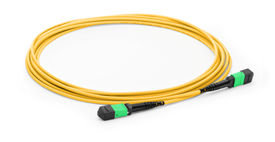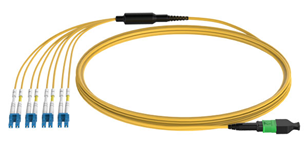

 Knowledge Base +
Knowledge Base +  2024.01.10
2024.01.10The transmission speed of QSFP (Quad Small Form-Factor Pluggable) modules can vary depending on the specific type and generation of the module. QSFP is a compact, hot-pluggable optical transceiver module used in data center and high-performance computing environments.
Here are some common QSFP modules and their associated transmission speeds:
QSFP:
Data Rate: QSFP modules were initially introduced to support data rates up to 40 Gigabits per second (Gbps).
Applications: Commonly used for 40 Gigabit Ethernet (40GbE) connections.
QSFP+ (Plus):
Data Rate: QSFP+ modules support data rates up to 40 Gbps (4 x 10 Gbps) and are backward compatible with the original QSFP modules.
Applications: Used for 40GbE and 10 Gigabit Ethernet (10GbE) connections.
QSFP28:
Data Rate: QSFP28 modules support data rates up to 100 Gbps (4 x 25 Gbps).
Applications: Widely used for 100GbE connections and other high-speed networking applications.
QSFP56:
Data Rate: QSFP56 modules support data rates of 200 Gbps and 400 Gbps, making them suitable for higher-bandwidth requirements.
Applications: Used for 200GbE and 400GbE connections.
QSFP-DD (Double Density):
Data Rate: QSFP-DD modules support even higher data rates, including 200 Gbps and 400 Gbps per module.
Applications: Designed for next-generation high-density and high-speed networking applications.
It's important to note that the term "QSFP" by itself may refer to the original QSFP or QSFP+ modules, and the specific data rate will depend on the generation of the module. Advancements in technology have led to higher-speed variants like QSFP28, QSFP56, and QSFP-DD to meet the increasing demand for faster data transmission in modern data centers and networks. Always refer to the documentation provided by the equipment manufacturer for accurate information on the supported data rates of QSFP modules in your network infrastructure.
400G-PLR4 or 4x100G QSFP-DD transceiver, up to 10km over parallel single mode fiber (SMF). The 400G-PLR4 can break out to 4 x 100G, and interop with 4 x 100G-LR1 QSFP28. Parallel SMF MPO-12 Angled Connector (APC)
A cost optimized solution for up to 10km. Customers can use it for 400G to 400G connectivity as well as breakout 400G to 4x100G connectivity. Breakout option is often used for Leaf to ToR, in conjunction with 100G LR1 (100G LR1 is a new single lambda QSFP28 optics module used to plug into legacy 100G switches with NRZ electrical signals).

The 400G-DR4 / XDR4 / PLR4 modules use a single row, angled (APC) MPO12 connector for use with parallel single mode fiber. Although a MPO12 cable can have up to 12 SMF fibers, only 8 out of the 12 fibers are used (4 for Tx and 4 for Rx). This is the same connector that is used on existing 100G and 40G QSFPs that use parallel SMF (e.g. 100G-PSM4, 40GPLR4 etc). An image, and drawing of an MPO12 connector are shown below.

EN-MTP8F-SM-FF-xxM is singlemode patch cable required for direct connectivity between QDD-XDR4.

EN-MTP4LCxxSM is a Singlemode MTP to 4 Duplex LC breakout cable is required to connect to 4 x QSFP-100G-LR1s (EN-QSFP28-LR1) or to a single 400G-PLR4

Subscribe to the newsletter
for all the latest updates.
2-5# Building, Tongfuyu Industrial Zone, Aiqun Road, Shiyan Street, Baoan District, Shenzhen. China
